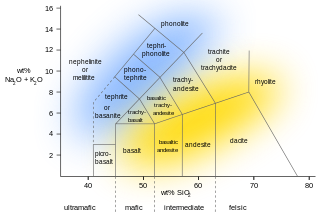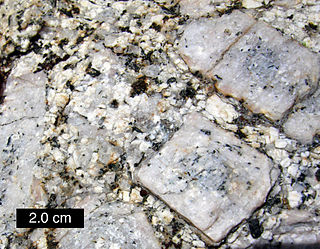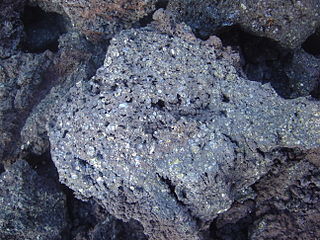
Gabbro is a phaneritic, mafic intrusive igneous rock formed from the slow cooling magma into a holocrystalline mass deep beneath the Earth's surface. Slow-cooling, coarse-grained gabbro is chemically equivalent to rapid-cooling, fine-grained basalt. Much of the Earth's oceanic crust is made of gabbro, formed at mid-ocean ridges. Gabbro is also found as plutons associated with continental volcanism. Due to its variant nature, the term gabbro may be applied loosely to a wide range of intrusive rocks, many of which are merely "gabbroic". By rough analogy, gabbro is to basalt as granite is to rhyolite.

Basalt is an aphanitic (fine-grained) extrusive igneous rock formed from the rapid cooling of low-viscosity lava rich in magnesium and iron exposed at or very near the surface of a rocky planet or moon. More than 90% of all volcanic rock on Earth is basalt. Rapid-cooling, fine-grained basalt is chemically equivalent to slow-cooling, coarse-grained gabbro. The eruption of basalt lava is observed by geologists at about 20 volcanoes per year. Basalt is also an important rock type on other planetary bodies in the Solar System. For example, the bulk of the plains of Venus, which cover ~80% of the surface, are basaltic; the lunar maria are plains of flood-basaltic lava flows; and basalt is a common rock on the surface of Mars.

Dacite is a volcanic rock formed by rapid solidification of lava that is high in silica and low in alkali metal oxides. It has a fine-grained (aphanitic) to porphyritic texture and is intermediate in composition between andesite and rhyolite. It is composed predominantly of plagioclase feldspar and quartz.

Trachyte is an extrusive igneous rock composed mostly of alkali feldspar. It is usually light-colored and aphanitic (fine-grained), with minor amounts of mafic minerals, and is formed by the rapid cooling of lava enriched with silica and alkali metals. It is the volcanic equivalent of syenite.

Latite is an igneous, volcanic rock, with aphanitic-aphyric to aphyric-porphyritic texture. It is the volcanic equivalent of monzonite. Its mineral assemblage is usually alkali feldspar and plagioclase in approximately equal amounts. Quartz is less than five percent and is absent in a feldspathoid-bearing latite, and olivine is absent in a quartz-bearing latite. When quartz content is greater than five percent the rock is classified as quartz latite. Biotite, hornblende, pyroxene and scarce olivine or quartz are common accessory minerals. Feldspathoid-bearing latite is sometimes referred to as tristanite.

Andesite is a volcanic rock of intermediate composition. In a general sense, it is the intermediate type between silica-poor basalt and silica-rich rhyolite. It is fine-grained (aphanitic) to porphyritic in texture, and is composed predominantly of sodium-rich plagioclase plus pyroxene or hornblende.

Basanite is an igneous, volcanic (extrusive) rock with aphanitic to porphyritic texture. It is composed mostly of feldspathoids, pyroxenes, olivine, and calcic plagioclase and forms from magma low in silica and enriched in alkali metal oxides that solidifies rapidly close to the Earth's surface.

Porphyry is any of various granites or igneous rocks with coarse-grained crystals such as feldspar or quartz dispersed in a fine-grained silicate-rich, generally aphanitic matrix or groundmass. In its non-geologic, traditional use, the term porphyry usually refers to the purple-red form of this stone, valued for its appearance, but other colours of decorative porphyry are also used such as "green", "black" and "grey".

Extrusive rock refers to the mode of igneous volcanic rock formation in which hot magma from inside the Earth flows out (extrudes) onto the surface as lava or explodes violently into the atmosphere to fall back as pyroclastics or tuff. In contrast, intrusive rock refers to rocks formed by magma which cools below the surface.

Porphyritic is an adjective used in geology to describe igneous rocks with a distinct difference in the size of mineral crystals, with the larger crystals known as phenocrysts. Both extrusive and intrusive rocks can be porphyritic, meaning all types of igneous rocks can display some degree of porphyritic texture. Most porphyritic rocks have bimodal size ranges, meaning the rock is composed of two distinct sizes of crystal.

Volcanic rocks are rocks formed from lava erupted from a volcano. Like all rock types, the concept of volcanic rock is artificial, and in nature volcanic rocks grade into hypabyssal and metamorphic rocks and constitute an important element of some sediments and sedimentary rocks. For these reasons, in geology, volcanics and shallow hypabyssal rocks are not always treated as distinct. In the context of Precambrian shield geology, the term "volcanic" is often applied to what are strictly metavolcanic rocks. Volcanic rocks and sediment that form from magma erupted into the air are called "pyroclastics," and these are also technically sedimentary rocks.

Intrusive rock is formed when magma penetrates existing rock, crystallizes, and solidifies underground to form intrusions, such as batholiths, dikes, sills, laccoliths, and volcanic necks.

Lamprophyres are uncommon, small-volume ultrapotassic igneous rocks primarily occurring as dikes, lopoliths, laccoliths, stocks, and small intrusions. They are alkaline silica-undersaturated mafic or ultramafic rocks with high magnesium oxide, >3% potassium oxide, high sodium oxide, and high nickel and chromium.

Komatiite is a type of ultramafic mantle-derived volcanic rock defined as having crystallised from a lava of at least 18 wt% magnesium oxide (MgO). It is classified as a 'picritic rock'. Komatiites have low silicon, potassium and aluminium, and high to extremely high magnesium content. Komatiite was named for its type locality along the Komati River in South Africa, and frequently displays spinifex texture composed of large dendritic plates of olivine and pyroxene.

Picrite basalt or picrobasalt is a variety of high-magnesium olivine basalt that is very rich in the mineral olivine. It is dark with yellow-green olivine phenocrysts (20-50%) and black to dark brown pyroxene, mostly augite.

Cumulate rocks are igneous rocks formed by the accumulation of crystals from a magma either by settling or floating. Cumulate rocks are named according to their texture; cumulate texture is diagnostic of the conditions of formation of this group of igneous rocks. Cumulates can be deposited on top of other older cumulates of different composition and colour, typically giving the cumulate rock a layered or banded appearance.
The tholeiitic magma series is one of two main magma series in subalkaline igneous rocks, the other being the calc-alkaline series. A magma series is a chemically distinct range of magma compositions that describes the evolution of a mafic magma into a more evolved, silica rich end member. Rock types of the tholeiitic magma series include tholeiitic basalt, ferro-basalt, tholeiitic basaltic andesite, tholeiitic andesite, dacite and rhyolite. The variety of basalt in the series was originally called tholeiite but the International Union of Geological Sciences recommends that tholeiitic basalt be used in preference to that term.

In geology, texture or rock microstructure refers to the relationship between the materials of which a rock is composed. The broadest textural classes are crystalline, fragmental, aphanitic, and glassy. The geometric aspects and relations amongst the component particles or crystals are referred to as the crystallographic texture or preferred orientation. Textures can be quantified in many ways. A common parameter is the crystal size distribution. This creates the physical appearance or character of a rock, such as grain size, shape, arrangement, and other properties, at both the visible and microscopic scale.

Alkali basalt or alkali olivine basalt is a dark-colored, porphyritic volcanic rock usually found in oceanic and continental areas associated with volcanic activity, such as oceanic islands, continental rifts and volcanic fields. Alkali basalt is characterized by relatively high alkali (Na2O and K2O) content relative to other basalts and by the presence of olivine and titanium-rich augite in its groundmass and phenocrysts, and nepheline in its CIPW norm.

Igneous rock, or magmatic rock, is one of the three main rock types, the others being sedimentary and metamorphic. Igneous rocks are formed through the cooling and solidification of magma or lava.




















